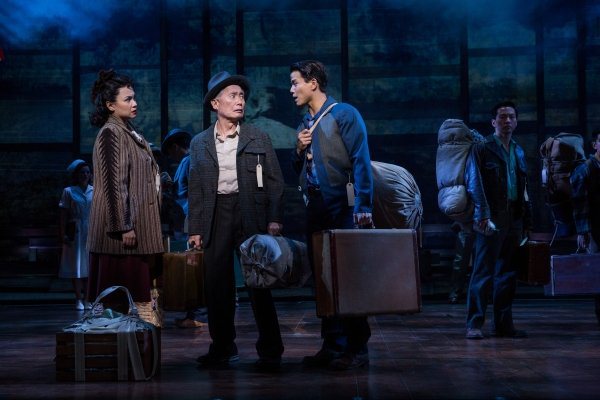
SPOILER ALERT: THIS BLOG REVEALS SOME PLOT POINTS
By Frank Abe
The implied pact the musical Allegiance makes with its audience is that you will see an honest retelling of the Japanese American incarceration, and come away feeling comfortably uplifted. The show does entertain, through derivative songs and animated production. It achieves its effect, however, by sacrificing truth for theatricality, revising history, and offering a ludicrous portrayal of the Heart Mountain resisters.
As producer/director of the 2000 PBS film, Conscience and the Constitution – which first framed the conflict between the organized resistance led by Frank Emi, and suppression of that resistance by the Japanese American Citizens League, led by Mike Masaoka – I’ve been asked how the musical performs as history.
After seeing the first public preview October 6 at New York’s Longacre Theater, it is apparent the makers of Allegiance found the fact of civilian administration of America’s concentration camps so ordinary and banal – which it was – that they needed to heighten the barriers to their themes of love and hope by conflating Heart Mountain with the worst of the segregation center at Tule Lake, near the California-Oregon border. They invent military rule at Heart Mountain.

Allegiance is billed as a fiction “inspired by the true-life experience of its star George Takei,” who was imprisoned as a child at Rohwer and Tule Lake. But the only events validated by his personal experience are those of every camp story – fictional family at home, Pearl Harbor, selling the farm cheap, dust and dances in camp, yes-yes/no-no, and war’s end. Once that family, here called the Kimura’s, is evicted from home and reaches the War Relocation Authority center in Wyoming, the makers of Allegiance selectively and progressively alter the reality governing Heart Mountain to more closely suggest that of a German POW camp.
In Act I for example, upon their arrival at faux Heart Mountain, a camp-wide PA system broadcasts directives to evacuees, while Military Police order “women to the right, men to the left.” Hannah, a white nurse, asks the women to “please remove your clothes down to your underwear” for medical exams. When an Issei woman protests, a young man explodes, “It’s not right!” and is forcibly shoved to the ground by an MP. The PA announces a curfew at sundown. When the Kimura patriarch later angrily answers no-no on his loyalty questionnaire, MP’s march to his barrack to clap him into handcuffs and haul him away: “No touching,” they bark to his family.
Camp was degrading. It was dehumanizing. But this heavy-handed treatment inflames emotion at the expense of fact:
The entirety of the arrival processing is designed to foreshadow the personal, physical violence that is contrived later. Disturbingly, the staging also evokes a whiff of the ghoulish selection process of inmates at Nazi gas chambers.
Camp-wide loudspeakers existed in M*A*S*H, not Heart Mountain. Incarcerees only had to roll up their sleeves to receive inoculations after arrival. The curfew existed on the West Coast before eviction, not after removal to camp; where would they go?
The Military Police at Heart Mountain were an ominous presence, equipped with rifles and machine guns in nine guard towers. But their patrol of the towers and exterior gates ended several hundred feet outside the barbed wire fence that encircled the barracks, inside of which incarcerees policed themselves. Handcuffs were not used and were not needed on segregants put on the bus for Tule Lake, because in the high desert of Wyoming, there was nowhere to run.
Act I ends with the Kimura family son Sam, having enlisted in the Army, raising his hand to salute, while his sister’s sweetheart, Frankie Suzuki, raises his fist in defiance. “Frankie” is revealed in Act II as a stand-in for the

real-life Frank Emi. But where Conscience presents the resistance for what it was – a studied act of civil disobedience, a last chance to challenge the legality of the camps by breaking a law and bringing a test case to court — Allegiance appropriates that framework and recasts the resisters as the oppressed, fists-raised revolutionaries from Les Misérables (“Resist”).
Reporters ask Sam Kimura, now a war hero, how he feels about “the draft riots at Heart Mountain” where resisters led by Frank Suzuki “are burning their draft cards.” Frankie exclaims to sweetheart Kei Kimura, “They could hang me for treason!” (“This Is Not Over”). Frankie is hunted by armed guards inside the camp perimeter. Frankie is captured and thrown into a stockade at Heart Mountain, where he is kicked and beaten bloody by MP’s. Kei rallies the women to write letters appealing to the press, which they smuggle out of camp under their skirts (“Resist” reprise). From his prison cell, Frankie reports that “With the press getting a hold of our story, there’s word of letting us out early, maybe even a pardon.” (“Nothing in Our Way”).
This melodramatic behavior makes a mockery of the true accomplishment of the resisters:
Draft cards were burned at Berkeley in the 1960’s for the benefit of TV cameras, not in the 1940’s and not at Heart Mountain. The only riots in camp were at Manzanar, against camp administration and the JACL, and a strike at Tule Lake which led to two-and-a-half months of martial law.
The resisters knew they were risking five years in prison and a $10,000 fine for bucking the draft, but violating the recently enacted Selective Service Act was never a capital crime, never treason. And they never whined about the price of their principled stand.
Heart Mountain had no stockade; that was Tule Lake. No resistance leader at Heart Mountain was beaten bloody. If this scene is meant to play out in the federal penitentiary where they served their sentences, it’s more of an insult, because at Leavenworth Frank Emi earned the respect of guards and hardened convicts by staging an exhibition of the then unheard-of sport of judo.
America knew full well what was going on in the camps. The great majority applauded eviction, incarceration, JACL shows of patriotism, and the prosecution of so-called troublemakers. Publicity about the resisters would hardly cause the U.S. attorney or the federal judge who convicted them to wilt. As for getting publicity, Frank Emi only had to mail letters to the Wyoming newspaper to get them published; this bit of business seems contrived to give star Lea Salonga something to do. President Truman did pardon the Nisei resisters, but only after the war, and only along with all the draft resisters of WW2.
But more importantly, no resistance leader was hunted by guards like an inmate escaping Stalag 17. Leaders of the Fair Play Committee were quietly taken into custody at their family barracks by federal marshals who came at dawn. Guntaro Kubota even had his bags packed waiting for his arrest.
All this is an affront to Heart Mountain resister Yosh Kuromiya. He witnessed these events, and finds the stage play absurd:
There weren’t any firearms used in Heart Mountain. Our resistance was completely above-board and open. All the FPC meetings were open to the public. Even our bulletins were publicized.
The impressions given in this script are totally misleading. The whole situation wasn’t violent and it was an open forum for people to speak openly. The implications in the portrayal are an insult to the FPC and resisters. Even the rationale of artistic license becomes questionable in the critical accuracy of our personal history and that of Japanese American history.
The worst is saved for last. His bloody head now wrapped in bandages, Frankie – how I loathe that diminutive form of Frank Emi – is dragged by an MP to the infirmary. Hannah the nurse tries to treat him, but the MP punches Frankie around (!), pulls out his sidearm (!), and (SPOILER ALERT) in the scuffle shoots and kills Hannah by mistake.
Audiences gasp (except for one person, not me, who guffawed). But audience members do not realize this is no longer an historical fiction of the kind promised. This World War II exists in an alternate universe, science fiction as told by Phillip K. Dick. Four men were shot and killed in America’s wartime concentration camps, each of them a person of Japanese ancestry. No white woman was ever killed in camp, much less by another white person. None. Not ever. Such an incident would have rocked the course of American history. And in the plot’s climactic moment it is this death, not the uniquely Japanese American divide of patriot versus resister, that drives the final break between Kei and her 442 brother Sam, who blames her and Frankie for the tragedy.
This does not trouble the show’s makers, who freely acknowledge that their conception of Allegiance has as much to do with the WWII incarceration of Japanese Americans as Miss Saigon did with the war in Vietnam. The historical events exist only as a backdrop for their themes of love and hope. It’s an advancement on the Orientalist tradition of the Broadway theater, but audiences at least knew something about the Vietnam War. Without knowing much if anything about the camps, non-Nikkei audiences must accept the action at face value, unaware that most of the events described were impossible under the reality governing the camps. In this respect, Allegiance thumbs its nose at the history it purports to impart.
Incidentally, while the show is commonly known as “George Takei’s Allegiance,” he is not a producer with responsibility for the project. He is an impish presence on the stage as grandfather Kimura (and by the way, how is his character possible as the father of an Issei father?); he is a commanding presence as the grown-up Sam Kimura; and he growls out his one number in the spoken-singing style of Rex Harrison in My Fair Lady (“Ishi Kara Ishi”) while cleverly folding his loyalty questionnaire into the paper flower blossom seen in the show’s logo. Responsibility for historical fabrications lie with the creative team behind the book, or script. The team was lucky to have secured George’s services to front the show. Mr. Takei graciously provided a voice for our film, he’s done extraordinary work in the community, and people are made to feel that they share in his legacy project.

If the community’s interest in this show lies in the exposure and mainstreaming of the camp story, it has to look critically at what is being streamed. Art needn’t be slavishly accurate. Dramatists have leeway to condense and rearrange to arrive at an emotional truth. What we get here though is less an authentic sensibility and more the feel of product research, calibrated for fame, box office, and Tony nods.
Japanese Americans who protest “it’s only a musical,” that it might lead audiences to learn more, overlook the potential consequences. Should Allegiance stand, it risks supplanting the truth of the resistance and the Japanese American experience in the popular mind. Revisionism must be rejected – whether from camp deniers like Michelle Malkin who minimalize the experience, or from shows like this that make the camps out to be harsher than they were.
The Broadway crowd will embrace and defend its own, but Japanese America did not fight – I did not fight – to set the record straight through redress and restoration of the resisters, only to have verifiable fact sacrificed for a curtain call. For years, the makers have deflected criticism of their show as a work-in-progress. That ends in two weeks, when the show opens November 8 for review by the New York press. It will be left to critics and the community to recognize the revisionism, and call bullshit where they see it. Be wary of pledging allegiance to this distortion of Japanese American history.
Next: The portrayal of Mike Masaoka is actually one of the things this show gets right — even as it contributes to a false sense of resolution.
(This blog was originally published at Resisters.com)

